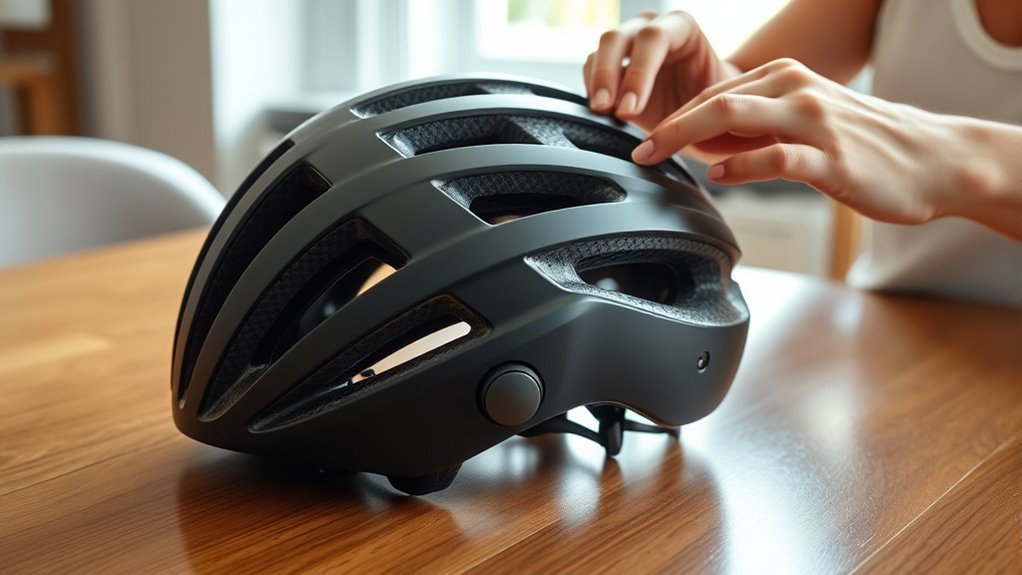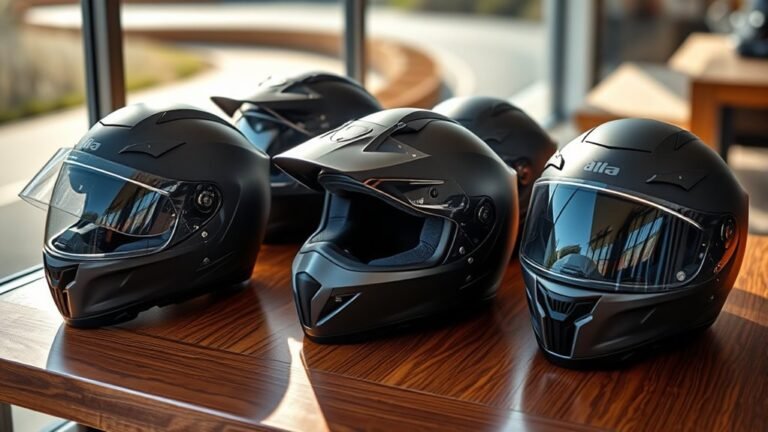How to Adjust Your E-Bike Helmet for Comfort
To adjust your e-bike helmet for comfort, start by measuring your head size for an accurate fit. Position the helmet level above your eyebrows and adjust the chin strap so it forms a V under your ears. Make sure it’s snug, allowing one finger to fit under the strap. Test for stability by shaking your head; the helmet shouldn’t move considerably. Regularly check for wear and learn how to maintain your helmet for peak safety.
Understanding Helmet Fit
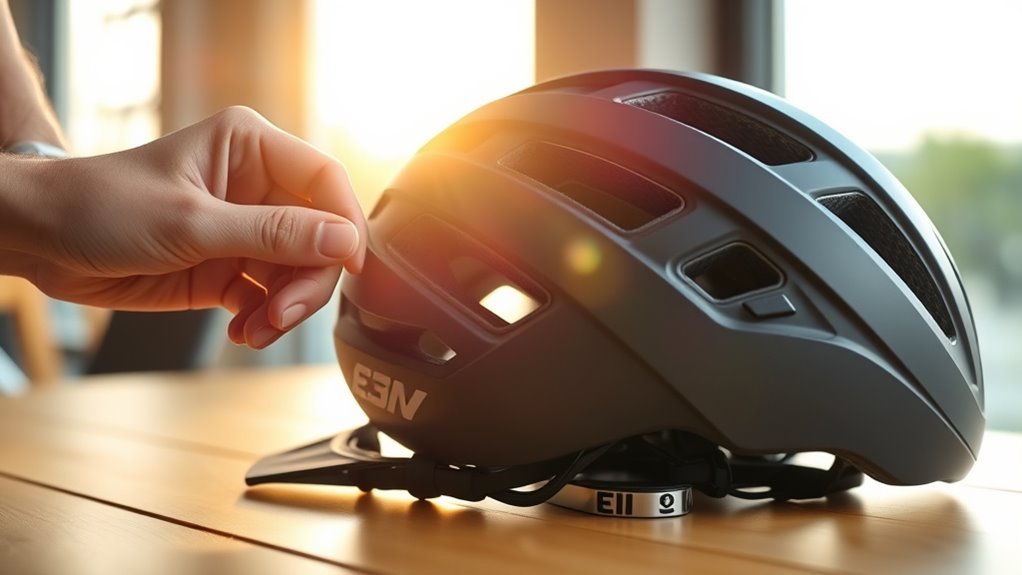
When it comes to safety, a well-fitted helmet is your best ally on an e-bike. Understanding helmet fit is essential for achieving ideal helmet comfort and protection. Start by adjusting the straps to guarantee they sit snugly against your chin without causing discomfort. A good fit should feel secure but not overly tight, allowing for adequate airflow. Pay attention to the retention system; it should keep the helmet stable while you ride. If your helmet has a dial or other fit adjustments, use them to attain that perfect balance between comfort and security. Remember, a helmet that fits well not only enhances safety but also allows you the freedom to ride confidently. Your adventures deserve nothing less.
Measuring Your Head Size
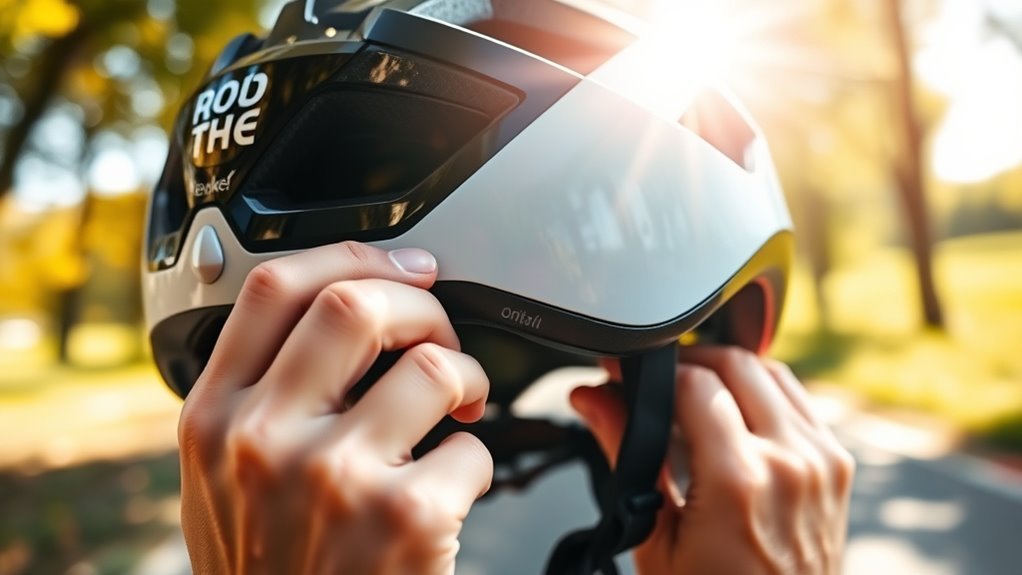
To find the right helmet size, measuring your head accurately is crucial. Start by using the right measurement tools to guarantee precision. Here’s how you can measure your head circumference effectively:
Measuring your head accurately is essential for finding the perfect helmet size. Use the right tools for precision.
- Grab a flexible measuring tape or a string.
- If using a string, mark where it overlaps, then measure that length with a ruler.
- Wrap the tape around the widest part of your forehead, just above your ears.
- Keep the tape snug but not too tight for an accurate reading.
- Record your measurement in centimeters or inches.
With your head circumference noted, you’ll be well-equipped to select a helmet that offers both comfort and safety, letting you ride freely and confidently.
Choosing the Right Helmet Style
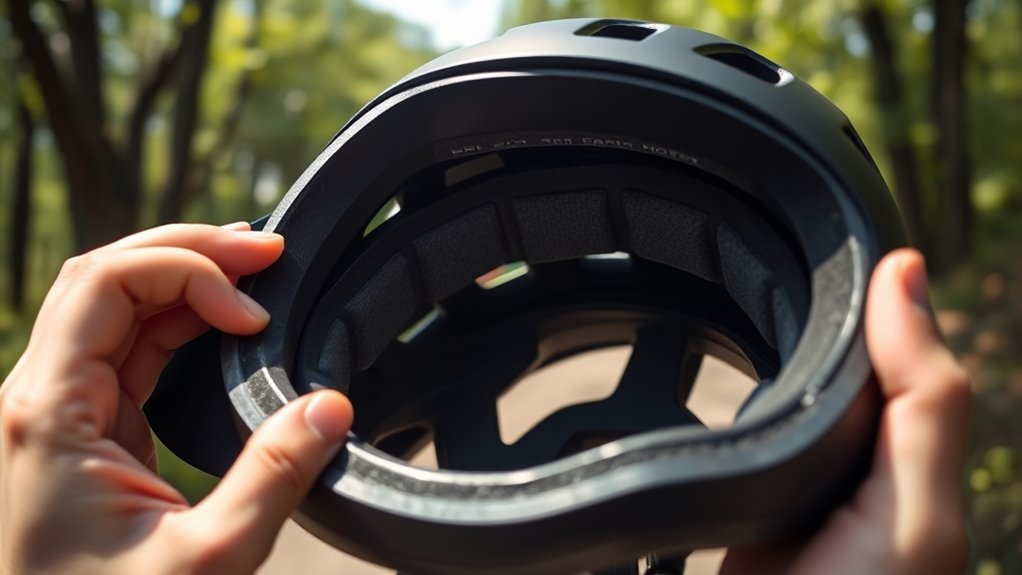
When choosing an e-bike helmet, it’s essential to take into account the different styles available, as each offers unique features and benefits. Fit and size also play a significant role in ensuring comfort and protection while riding. Finally, understanding safety ratings can help you select a helmet that meets the necessary standards for your rides.
Types of Helmet Styles
Selecting the right helmet style for your e-bike can greatly enhance both safety and comfort during your rides. With various options available, it’s essential to choose one that suits your needs. Here are some popular helmet styles:
- Full face helmets: Offer maximum protection, ideal for those who prioritize safety on rugged trails.
- Half shell helmets: Provide a balance of protection and ventilation, perfect for casual rides.
- Skate-style helmets: Stylish and comfortable, these helmets are great for urban commuting.
- Mountain bike helmets: Feature visors and enhanced airflow, designed for off-road adventures.
- Road bike helmets: Lightweight and aerodynamic, suitable for speed enthusiasts.
Pick the style that resonates with your riding lifestyle and safety requirements!
Fit and Size Matters
Choosing the right helmet style is just the beginning; verifying it fits properly is what truly matters for safety and comfort. A well-fitted helmet enhances helmet comfort and verifies it stays in place during your rides. Start by measuring your head circumference to find the right size. Once you have the right size, make fit adjustments using the internal mechanisms, such as straps and padding. The helmet should sit level on your head, snug but not overly tight. You should be able to wiggle your ears without feeling discomfort. Remember, a helmet that doesn’t fit well can compromise your safety and diminish your riding experience. Prioritize adjustments to achieve that perfect blend of comfort and security.
Safety Ratings Explained
Understanding safety ratings is essential for guaranteeing you pick a helmet that truly protects you while riding your e-bike. Knowing the different safety standards and helmet certifications can guide your choice effectively. Here are key factors to take into account:
- CPSC: Complies with U.S. Consumer Product Safety Commission standards.
- SNELL: Known for rigorous testing, offering high-impact protection.
- EN 1078: European standards for cycling helmets, emphasizing safety and comfort.
- ASTM: Focuses on performance for specific activities, including biking.
- Certification Labels: Look for helmets with visible certification labels to guarantee compliance.
Choosing a helmet that meets these safety standards not only enhances your protection but also allows you to ride with confidence and freedom.
Adjusting the Chin Strap
A properly adjusted chin strap is essential for guaranteeing your safety while riding an e-bike. To achieve the ideal chin strap adjustment, start by placing the helmet on your head and pulling the straps down. The straps should sit just above your ears, allowing for a secure yet comfortable fit. You should be able to fit one or two fingers between the strap and your chin; if it feels too loose or tight, adjust accordingly. This comfort fitting guarantees that your helmet stays in place while riding, protecting you from potential injuries. Remember, a well-fitted chin strap not only enhances safety but also maximizes your freedom to enjoy the ride without distractions.
Positioning the Helmet on Your Head
Once you’ve adjusted the chin strap, it’s important to position the helmet correctly on your head for maximum protection. Proper helmet placement guarantees your head alignment is ideal, allowing for both safety and comfort while you ride. Follow these guidelines for the best fit:
- Place the helmet level on your head, not tilted back or forward.
- Confirm it sits about an inch above your eyebrows.
- Adjust it so that it covers the back of your head without slipping.
- Check that the side straps form a “V” shape just below your ears.
- Make sure it feels snug but not uncomfortable.
Adjusting the Inner Padding
Adjusting the inner padding of your helmet is crucial for achieving a comfortable and secure fit. Start by removing the padding from the helmet, which often Velcros or snaps in place. Inspect the foam layers for thickness; if they’re too thick or thin, consider replacing them with alternatives that suit your head shape. When reattaching, make sure they sit snugly against your scalp without causing pressure points. This padding adjustment considerably contributes to comfort enhancement, allowing you to focus on your ride rather than discomfort. Remember, a well-fitted helmet not only protects but also enhances your freedom on the road. Take your time with these adjustments to guarantee a personalized fit that meets your riding demands.
Testing for Proper Fit
How can you tell if your e-bike helmet fits properly? Proper fit testing is essential for safety and comfort. Start with these evaluation steps:
Ensuring a proper fit for your e-bike helmet is crucial for safety and comfort. Follow these essential steps for evaluation.
- Place the helmet level on your head, just above your eyebrows.
- Adjust the straps so they form a V-shape under your ears.
- Fasten the chin strap snugly; you should only be able to fit one finger underneath.
- Shake your head gently; the helmet shouldn’t move considerably.
- Check for pressure points; it should feel snug but not overly tight.
Maintenance Tips for Your Helmet
To keep your e-bike helmet in top condition, you should clean it regularly and inspect it for any signs of damage. Wipe down the exterior with a mild soap solution and check for cracks or dents that could compromise safety. Regular maintenance not only extends the life of your helmet but also guarantees your protection while riding.
Cleaning Your Helmet Regularly
While you’re enjoying the ride on your e-bike, it’s easy to overlook the importance of maintaining your helmet, but regular cleaning is crucial for both hygiene and safety. Aim to clean your helmet every few weeks or after any intense ride. Here are some effective cleaning materials to use:
- Mild soap or detergent
- Soft cloth or sponge
- Warm water
- Disinfectant wipes
- Air dry in a shaded area
Be certain to focus on the interior padding, as it can accumulate sweat and bacteria. A clean helmet not only feels better but also enhances your riding experience. By adhering to a consistent cleaning frequency, you can guarantee your helmet remains in top shape, ready for your next adventure.
Inspecting for Damage Frequently
Cleaning your helmet is just one part of its upkeep; regular inspections for damage are equally important. You should check your helmet for cracks, dents, or any signs of wear that could compromise its durability. Remember, your helmet’s impact resistance is essential in protecting you during rides. If you notice any deformation or significant scratches, it’s time to replace your helmet. Don’t wait for an accident to occur; proactive checks guarantee that your gear remains reliable. Make it a habit to inspect your helmet after every ride, especially if you’ve had a fall. Your safety depends on having a helmet that’s in top condition, allowing you the freedom to ride confidently. Stay vigilant to maintain your helmet’s effectiveness.
Knowing When to Replace Your Helmet
Knowing when to replace your helmet is crucial for your safety, especially after an impact or significant wear. Helmets have a limited lifespan, typically lasting three to five years. Here are some signs it’s time for a replacement:
- Visible cracks or dents
- A significant impact, even if there’s no visible damage
- Loose or damaged straps
- A helmet that no longer fits snugly
- The foam interior feels compressed or deteriorated
Don’t compromise your safety by holding onto an aging helmet. Regularly check for these signs of replacement, and always prioritize your well-being while enjoying the freedom of your e-bike. Remember, a reliable helmet is fundamental for a safe and exhilarating ride.
Frequently Asked Questions
Can I Wear Glasses Under My E-Bike Helmet?
Yes, you can wear glasses under your e-bike helmet, but it’s vital to guarantee the helmet fits properly. Glasses compatibility is important; they shouldn’t push against your temples or slide down your nose. Adjust the helmet to maintain comfort without compromising safety. A well-fitted helmet will provide the freedom to ride confidently while keeping your vision clear. Just remember to check that your glasses don’t interfere with the helmet’s protective features.
How Do I Clean My Helmet Properly?
To clean your helmet properly, start by removing the inner padding and washing it with mild soap and water. For the outer shell, use a soft cloth and a gentle cleaning solution. Rinse thoroughly and let everything air dry. Remember, regular helmet maintenance is key; check for any cracks or wear. These helmet maintenance tips not only keep your gear looking fresh but also guarantee your safety on every ride.
Are There Specific Helmets for Different Weather Conditions?
Yes, there are specific helmets designed for different weather conditions. You might think all helmets are the same, but that’s not true. Helmets with ventilation features are perfect for hot days, allowing airflow to keep you cool. Conversely, those with insulation options are ideal for colder climates, keeping your head warm. Choosing the right helmet not only enhances comfort but also guarantees safety, letting you enjoy your ride in any weather.
What Materials Are Best for E-Bike Helmets?
For e-bike helmets, materials like polycarbonate and in-mold foam are ideal due to their lightweight properties and durability. These materials meet safety standards while ensuring comfort during long rides. Additionally, consider helmets with moisture-wicking liners for added convenience. When choosing, balance safety and weight considerations to maintain that sense of freedom while riding. A well-fitted, lightweight helmet not only protects you but enhances your overall experience on the road.
Can I Customize My Helmet With Stickers or Paint?
Yes, you can customize your helmet with stickers or paint, but be cautious! Altering your helmet’s exterior might impact its safety features, as some materials can compromise structural integrity. Helmet design trends are leaning towards personalization, but always guarantee any modifications don’t interfere with its protective qualities. Freedom of expression is crucial, but keeping safety at the forefront is essential. Choose non-toxic materials that won’t hinder your helmet’s ability to protect you.
